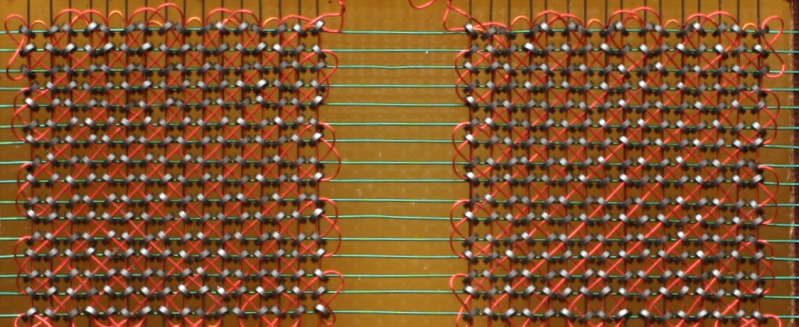There’s nothing quite like going to a museum and being given a tour by a docent who really knows their way around the exhibits. When that docent has first hand experience in the subject matter, the experience is enhanced even further. So you can imagine our excitement when hacker, maker, and former DEC mainframe memory engineer [Ned Utzig] published a tour of what he calls “Memories of Weird Memories of Computers Past.” [Ned] expertly guides us through each technology, adding flavor and nuance to an already fascinating subject.
The tour begins with early storage media such as IBM punch cards, and then walks us through time to the paper tape, vacuum tubes, and even complex vats of mercury — all used for the sake of storing data either permanently or temporarily.
Next in the exhibit is an impressive CRT hack that isn’t unlike modern DRAM. The tour continues on to ferrite core memory such as that used on mainframes, minicomputers, and even the Apollo Guidance Computer. Each type is examined for its strengths and weaknesses and its place in computing history.
We really appreciated the imaginative question posed toward the end of the article. We won’t give it away here- it’s worth it to go give The Mad Ned Memo a read.
Is obsolete technology your cup of tea? Perhaps an Arduino based experiment with core memory will scratch the itch, or maybe storing data in thin air will bring back memories of computers gone by.
















All sorts of weird stuff out there. The Friden EC-130 and it’s acoustic delay line, for example:
http://www.vintagecalculators.com/html/friden_ec-130.html
Bubble Memory deserves a mention.
https://www.youtube.com/watch?v=SIO3dc5F2kw
Oops, missed the link in the linked article. My mistake.
I work on Toshiba / shibaura CNC controls; A number of the controls from the late seventies to mid / late eighties utilized bubble memory for program and parameter storage. Definitely a cool rabbit hole of technology! I still service controls using bubble memory to this day, incredible to see this stuff working in harsh conditions for so long!
FANUC used it too. Fortunately third parties came out with SRAM cards that replaced them. They even had a way to transfer the memory contents of the bubble memory card to the sram card by plugging them together if I remember right.
Anyone interested in the practical details of driving core memory could do worse than watch Curious Marc’s demonstration on YouTube
https://youtu.be/AwsInQLmjXc
Thanks Ryan for the nice post about my article on Hackaday! One thing I am learning is I did not even scratch the surface of weird storage systems, based on comments I’ve gotten and comments I have seen here. Sounds like a part 2 in the making, perhaps!
-Mad Ned
I just dug out a little talked about memory to go on display at the upcoming Canberra “ACT AUS” retro computer fair. A “Magnetostrictive delay line memory” which transmits a stream torsional shock-waves along a coil of wire suspended on little rubber mounts. Like the mercury column it regenerates the data and then recycles it back in.
On another note. The first PDP8I hard drive “RF08” Named the Rotating File was a heavy disc with a spiral staggered set of fixed heads. It parallel loaded the data and was so fast (For it’s time) that it was mapped as the cache memory for the ferrite memory. Sort of the exact opposite to what modern chache did.
If you do a search on “The Witch Computer” which is at the computer museum “Bletchley Park”, you can read about a fascinating memory that uses dekatron display vacuum tubes to store register, accumulator and other data. Amazing!
They are building a replica of the Cambridge EDSAC computer. For safety reasons the original mercury delay line memories will instead be built as nickel delay lines.
Memory is something easy to forget about. I used to work at NCR Corp and different types of memory was in use outside of the computer room. The NCR 395 accounting machine read and wrote to long magnetic strips on the back of large paper ledger sheets. Bank accounts were kept up to date that way. The NCR 280 cash register (used by Macy’s/P A Bergners and others) used 2k and 4k magnetic core memory to hold the program for it’s 4004 processor chip and also sales totals. The NCR 2140 used NVRAM memory which required very tight voltage tolerances to function. The NCR 2126 used bubble memory to provide a bar code scanning file while other cash registers required a back office mini-mainframes for their scanning files. In the computer room NCR had CRAM (Card Random Access Memory) which were the size of the IBM Hollerith cards but magnetic and were fed through a reader similarly.
“Memory is something easy to forget about.”
https://instantrimshot.com/index.php?sound=rimshot&play=true
Makes me wonder why no one ever tried a “radio” delay line, transmit the data on a tight FM frequency to a repeater a fair distance away and have it transmit the data back to the computer.
Really bizarre choice to include Williams tubes but not drum memory. The latter was far more common.
A bit more modern, but reminded me of the mercury vats: The IBM racetrack memory by Stuart Parkin
https://www.ibm.com/ibm/history/ibm100/us/en/icons/racetrack/
https://researcher.watson.ibm.com/researcher/view_page.php?id=7082
enjoyed this post, thank you.